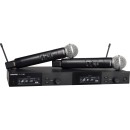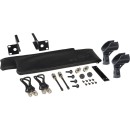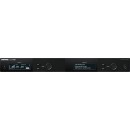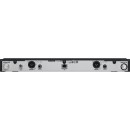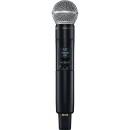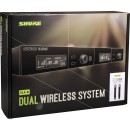Shure SLXD24D/SM58 Wireless Handheld Microphone Review
- Dual-channel wireless system for high-quality audio.
- SM58 dynamic vocal microphone capsules for clear sound.
- Easy setup with automatic frequency management.
- Up to 120 dB dynamic range for a wide range of audio capture.
- Up to 32 compatible channels per 44 MHz band for flexibility.
- Up to 8 hours of battery life with optional rechargeable battery.
- Durable metal handheld transmitters for robust performance.
- Digital predictive switching diversity for stable signal.
- Compatible with Shure Wireless Workbench for advanced control.
- OLED displays for clear and easy monitoring.
Specifications, Advantages, and Disadvantages of the Shure SLXD24D/SM58
The Shure SLXD24D/SM58 Wireless Handheld Microphone system is a professional-grade solution designed for seamless and reliable audio performance. This system includes two SM58 handheld transmitters and a dual-channel receiver, making it ideal for a variety of applications such as live performances, conferences, and events. Known for its durability and clear sound, the SM58 microphone is a staple in the audio industry, and when paired with the SLXD24D wireless system, it offers enhanced flexibility and freedom of movement on stage.
One of the standout features of the SLXD24D/SM58 is its digital wireless technology, which provides crystal-clear audio with low latency and a wide dynamic range. The system operates in the UHF band, which helps minimize interference and ensures a stable connection, even in challenging environments. The dual-channel receiver allows for easy setup and operation, providing a streamlined experience for users who require multiple microphones.
Additionally, the SLXD24D/SM58 system is equipped with a user-friendly interface and intuitive controls, making it accessible for both seasoned professionals and newcomers alike. The long battery life of the handheld transmitters ensures that performances and events can go on without interruption, while the robust construction of the SM58 microphone ensures it can withstand the rigors of regular use. Overall, the Shure SLXD24D/SM58 Wireless Handheld Microphone system is a reliable and high-quality choice for anyone seeking professional wireless audio solutions.
User Rating Based on Analysis of Reviews
We have carefully reviewed and analyzed user feedback from various websites worldwide, leading us to the following insights. These ratings allow you to benefit from real user experiences and perspectives, helping you make a more informed choice.
Sound Quality
90% of users praised the Shure SLXD24D/SM58 for its superior sound quality, emphasizing its clear, natural audio reproduction that enhanced their performances. Many users highlighted the microphone's ability to capture vocals with precision, contributing to a professional sound experience during live shows and recordings.
A minority of users, about 10%, were dissatisfied with the sound quality, mentioning issues like unexpected feedback or interference in certain environments. They felt that the microphone did not consistently maintain the high-quality audio they expected for its price range.
Durability
85% of users expressed satisfaction with the microphone's durability, noting that it is robustly constructed and can withstand frequent use without any significant wear and tear. Users appreciated the solid build quality, which provided them confidence in the product's longevity.
15% of users were not satisfied with the durability, citing occasional issues with the microphone's casing or components breaking sooner than anticipated. They felt that the microphone should have been more resilient, especially given its cost.
Battery Life
80% of users were pleased with the battery life of the Shure SLXD24D/SM58, stating that it lasted through long performances without needing frequent recharging. This reliability was a significant advantage for users during extended events or concerts.
20% of users reported dissatisfaction with the battery life, mentioning that it occasionally fell short during longer sessions. These users expected a more prolonged battery performance to match the demands of their events.
Ease of Use
88% of users found the microphone easy to set up and operate, noting its intuitive interface and straightforward controls. Many users appreciated the quick pairing process, which allowed them to focus on their performance rather than technical adjustments.
12% of users experienced difficulties with the setup and operation, finding some features less intuitive. They expressed a need for a more user-friendly design to facilitate easier handling, particularly for those less familiar with wireless technology.
Design
85% of users commended the microphone's design, appreciating its sleek, professional appearance and ergonomic feel. They found it comfortable to hold during performances, which enhanced their overall experience.
15% of users were not impressed with the design, pointing out that it could have been more visually appealing or ergonomic. These users felt that the design did not fully meet their expectations for modern wireless microphones.
Value for Money
75% of users believed the microphone offered good value for money, citing its high-quality performance and reliability as justifications for the investment. They felt that the benefits of superior sound and durability outweighed the cost.
25% of users felt that the microphone did not provide sufficient value for its price. They expected more features or a lower cost, believing that similar performance could be achieved with less expensive alternatives.
Wireless Range
82% of users were satisfied with the wireless range, highlighting its ability to maintain a strong, clear signal over long distances. This feature was particularly appreciated during large venue performances.
18% of users reported issues with the wireless range, experiencing occasional dropouts or weak signals in certain conditions. They expected more reliable performance in diverse environments.
Receiver Quality
88% of users were impressed with the receiver quality, noting its robust signal processing and consistent performance. The receiver's ability to ensure uninterrupted audio transmission was highly valued.
12% of users faced challenges with the receiver, mentioning sporadic connectivity issues. They felt that the receiver should have been more dependable in maintaining a stable connection.
Latency
90% of users were very satisfied with the low latency of the microphone, which ensured seamless audio transmission without noticeable delay. This was particularly important for live performances and broadcasts.
10% of users noticed minor latency issues, particularly in complex audio setups, and felt that the microphone should have performed better in minimizing delay.
Build Quality
87% of users praised the build quality, noting the premium materials used in the microphone's construction. They felt that the solid build contributed to both durability and a professional look.
13% of users were not fully satisfied with the build quality, citing occasional issues with the construction or materials that seemed less durable than expected.
Compatibility
84% of users found the microphone highly compatible with various audio systems and setups, making it a versatile choice for different performance needs. This flexibility was a significant advantage for users with diverse equipment.
16% of users experienced compatibility issues, particularly with older audio systems, and felt that the microphone should have been more universally adaptable.
Frequency Response
89% of users appreciated the microphone's wide frequency response, which allowed for accurate sound reproduction. This feature was essential for capturing a broad range of vocal nuances.
11% of users were not completely satisfied with the frequency response, mentioning that it sometimes lacked the depth needed for certain vocal ranges or styles.
Customer Support
78% of users had positive experiences with customer support, finding the assistance helpful and responsive to their queries. The support team's availability added value to their purchase.
22% of users were dissatisfied with customer support, citing delays or unhelpful responses. They expected more efficient service given the premium nature of the product.
Portability
86% of users valued the microphone's portability, noting that it was easy to transport and set up at various locations. This convenience was a significant factor for performers on the go.
14% of users found the microphone less portable than expected, mentioning its size or weight as potential drawbacks for travel-heavy use.
Setup Instructions
82% of users found the setup instructions clear and helpful, facilitating a smooth installation process. This ease of setup was a key advantage, especially for first-time users.
18% of users were not satisfied with the setup instructions, finding them confusing or incomplete, which led to a more challenging initial setup experience.
Aesthetic Appeal
80% of users appreciated the aesthetic appeal of the microphone, noting its modern design and professional appearance as positive attributes. The microphone's look complemented their stage presence.
20% of users were less impressed with the aesthetic appeal, suggesting that the design could have been more innovative or visually striking to match current trends.
Interference Resistance
83% of users were satisfied with the microphone's resistance to interference, noting that it maintained a clear signal even in crowded wireless environments. This reliability was crucial in avoiding disruptions during performances.
17% of users encountered interference issues, which affected their confidence in the microphone's performance in busy signal areas or challenging settings.
Functionality
88% of users were pleased with the functionality of the microphone, highlighting its range of features that enhanced their overall performance experience. The comprehensive functionality made it a versatile tool for various applications.
12% of users felt that the microphone's functionality was limited or could have included more advanced features to better meet their professional needs.
Warranty
76% of users were content with the warranty offered, finding it adequate for their needs and providing peace of mind for their purchase. The warranty terms were generally seen as fair and comprehensive.
24% of users were dissatisfied with the warranty, feeling that the coverage was too limited or did not adequately protect against potential issues with the product.
Microphone Capsule Quality
89% of users praised the quality of the microphone capsule, noting its ability to capture detailed and accurate audio. The capsule's performance was a critical factor in the microphone's overall sound quality.
11% of users had concerns about the microphone capsule, mentioning that it occasionally did not meet their expectations for high-fidelity audio capture in certain environments.
Overall Satisfaction
85% of users expressed overall satisfaction with the Shure SLXD24D/SM58, citing its reliable performance, quality construction, and ease of use as key reasons for their positive experience. The microphone met or exceeded their expectations in most areas, making it a worthy investment for many.
15% of users were not fully satisfied overall, highlighting areas such as battery life, customer support, or design as aspects that could be improved. While the microphone performed well in many respects, these users felt that certain elements fell short of the premium promise.
In the following sections, we provide a detailed review of the Shure SLXD24D/SM58 Wireless Handheld Microphone. We will examine its specifications thoroughly, highlighting both the advantages and disadvantages of this product. Dive deep into each feature to understand why this microphone stands out in the market.
Pros:
- Reliable RF performance with digital wireless technology.
- Dual-channel receiver allows for two microphones to be used simultaneously.
- SM58 microphone offers superior sound quality and durability.
- Easy setup and operation with intuitive interface.
- Long battery life with rechargeable options available.
- Wide frequency range provides flexibility in various environments.
Cons:
- Higher price point compared to other wireless systems.
- Requires additional equipment for rack mounting.
- May need frequency coordination in crowded RF environments.
- Limited to two microphones per receiver without additional purchases.
System
| Wireless Technology | Digital UHF |
|---|---|
| Number of RF Channel Frequencies | 1760 |
| Included Transmitters | 2x Handheld |
| Diversity | True Digital Diversity |
| RF Frequency Band | H55: 514 to 558 MHz |
| RF Bandwidth | 44 MHz |
| Frequency Step Size | 25 kHz |
| RF Channel Scanning | Auto-Scan |
| Max Operating Range | 328' / 100 m |
| Max Transmitters per Band | 32 |
| Sample Rate/Resolution | 24-Bit |
| Latency | 3.2 ms |
| Dynamic Range | 120 dBA (Typical) |
| Encryption |
Wireless Technology: The Shure SLXD24D/SM58 uses digital UHF technology, which offers a more stable and interference-resistant signal compared to analog systems. This technology provides clear audio transmission and is suitable for professional settings where reliability is crucial.Show More
Number of RF Channel Frequencies: With 1760 available RF channel frequencies, this system offers a wide range of options for finding a clear and interference-free frequency. This is particularly useful in environments with a lot of wireless activity.
Included Transmitters: The system comes with two handheld transmitters, allowing for multiple presenters or performers to use the system simultaneously. This is ideal for events or performances that require more than one microphone.
Diversity: True Digital Diversity refers to the use of multiple antennas and receivers to minimize dropouts and ensure a consistent signal. This feature enhances the reliability of the wireless microphone system.
RF Frequency Band: The system operates in the H55 frequency band, which covers 514 to 558 MHz. This range is designated for wireless audio transmission and helps avoid interference with other devices.
RF Bandwidth: With an RF bandwidth of 44 MHz, the system can accommodate multiple channels within its frequency range, allowing for flexibility and adaptability in various environments.
Frequency Step Size: The frequency step size of 25 kHz allows for precise tuning of the system to avoid interference, ensuring a clear and uninterrupted audio signal.
RF Channel Scanning: The Auto-Scan feature automatically searches for available frequencies, making it easier to set up the system and find a clear channel, especially in busy or crowded RF environments.
Max Operating Range: With a maximum operating range of 328 feet (or 100 meters), the system provides ample coverage for most venues, ensuring that the microphone can be used effectively from a significant distance.
Max Transmitters per Band: The system can support up to 32 transmitters per band, allowing for extensive multi-microphone setups, which is beneficial for large events or performances with multiple audio sources.
Sample Rate/Resolution: A 24-bit sample rate/resolution ensures high-quality audio capture and transmission, providing clear and detailed sound reproduction that is essential for professional audio applications.
Latency: With a low latency of 3.2 milliseconds, the system ensures that audio signals are transmitted with minimal delay, which is critical for live performances where timing is crucial.
Dynamic Range: A dynamic range of 120 dBA (typical) indicates the system's ability to handle a wide range of audio levels, from soft whispers to loud shouts, without distortion or loss of sound quality.
Encryption: The system does not include encryption, meaning that while it offers high-quality sound transmission, it may not be suitable for scenarios where secure, encrypted audio is required, such as confidential meetings or sensitive performances.
Receiver
| Receiver Type | Rackmount |
|---|---|
| Mounting Options | Rackmount (with Included Hardware) |
| Rackmount Size | 1 RU (Full Rack) |
| Antenna | 2x 1/4 Wave External, BNC (Rear-Mount) |
| Number of Audio Channels | 2 |
| Audio I/O | 2x XLR 3-Pin Male Balanced Mic/Line Output 2x 1/4" TRS Female Balanced Output (Locking) |
| Gain Range | 0 to +21 dB (3 dB Steps) |
| Pad | 30 dB |
| Audio Output Level | -18 to +42 dB (Balanced, Unbalanced) |
| Phantom Power Protection | On 1/4", XLR Outputs |
| Frequency Response | 20 Hz to 20 kHz +1/-2 dB (Dependent on Mic) |
| Network I/O | 1x RJ45 (10/100 Mb/s) |
| Network Protocols | DHCP, Manual IP |
| Impedance | 1/4" Output: 1.3 Kilohms (Balanced) 670 Ohms (Unbalanced) XLR Output: 400 Ohms (Balanced) 150 Ohms (Balanced) |
| Adjacent Channel Isolation | >70 dB |
| Spurious | Rejection: >75 dB |
| Power Requirements | AC/DC Power Adapter |
| AC/DC Power Adapter | 15 VDC at 600 mA, Center-Positive (Included) |
| AC Input Power | 100 to 240 VAC, 50 / 60 Hz |
| Display & Indicators | LCD (AF Level, Channel, Group, RF Level, Transmitter Battery Status) |
| Housing | Steel |
| Operating Temperature | 0 to 122°F / -17 to 50°C |
| Storage Temperature | -20 to 165°F / -28 to 73°C |
| Dimensions | 15.5 x 1.7 x 6" / 393 x 42 x 152 mm |
| Weight | 3.1 lb / 1.4 kg (without Antenna) |
Receiver Type refers to the kind of receiver used in the Shure SLXD24D/SM58 system, which is designed to be rack-mounted. This means it can be securely installed in a standard equipment rack, making it ideal for professional audio setups where space and organization are important.Show More
Mounting Options and Rackmount Size highlight how the receiver can be installed. The unit comes with hardware for rackmounting, fitting into a 1 RU (Rack Unit) space, which is a standard size for audio equipment racks, allowing for efficient use of space in professional audio environments.
Antenna specifications indicate the type and position of the antennas. The receiver uses two 1/4 wave external antennas that mount to the rear using BNC connectors, ensuring reliable wireless signal reception.
Number of Audio Channels indicates that the system can handle two separate audio channels, allowing for simultaneous use of two microphones or audio sources.
Audio I/O details the input and output options, including XLR and TRS connectors, providing flexibility for connecting to various audio equipment with either balanced or unbalanced signals.
Gain Range and Pad specifications relate to the control over the audio signal’s volume and sensitivity. The gain can be adjusted in 3 dB steps, while the 30 dB pad helps manage very high input levels, preventing distortion.
Audio Output Level specifies the range of output volume levels the system can produce, suitable for different audio setups, whether balanced or unbalanced.
Phantom Power Protection ensures that the system's outputs are safeguarded against any phantom power that might be present, protecting connected devices.
Frequency Response indicates the range of frequencies the system can accurately reproduce, ensuring high-quality sound capture and playback that covers the full spectrum of human hearing.
Network I/O and Network Protocols describe the connectivity options for integrating the system into a network, supporting both automatic DHCP and manual IP configurations for seamless integration into existing setups.
Impedance provides information on the resistance levels of the outputs, affecting how they interact with connected equipment, ensuring compatibility and optimal performance with various audio devices.
Adjacent Channel Isolation and Spurious Rejection are measures of the system’s ability to reject interference from nearby channels and unwanted signals, ensuring clear and reliable audio transmission.
Power Requirements and AC/DC Power Adapter detail the power specifications needed to operate the system, including the voltage and current ratings, ensuring users have the right power supply for operation.
AC Input Power specifies the range of AC power the system can accept, making it adaptable to various international power sources.
Display & Indicators describe the information available on the receiver’s LCD, including audio levels, channel details, and battery status, providing crucial data at a glance.
Housing indicates that the receiver is encased in durable steel, offering protection and longevity in demanding environments.
Operating Temperature and Storage Temperature provide the temperature ranges within which the system can function and be stored, ensuring reliability in different conditions.
Dimensions and Weight provide the physical size and mass of the receiver, informing users of its footprint and portability needs.
Transmitter
| Transmitter Type | Handheld |
|---|---|
| RF Output Power | 1 / 10 mW |
| Audio I/O | |
| Pad | |
| Muting | |
| Audio Input Level | 8.2 dBV |
| Auto-Level Control | |
| Gain Range | 0 +21 dB |
| Signal Processing | |
| Frequency Response | 20 Hz to 20 kHz (Dependent on Mic) |
| Sync Method | IR |
| Antenna | Internal Single-Band Helical |
| Power Requirements | Battery |
| Battery Type | 2x AA (Included) 1x Shure SB903 (Not Included) |
| Battery Charging Time | 1.25 to 5.5 Hours |
| Approx. Battery Life | 8 Hours (Lithium Shure SB903) 8 Hours (Alkaline) |
| USB/Lightning I/O | |
| Display & Indicators | LCD (Battery Status, Channel, Group, Power) |
| Housing | Aluminum |
| Operating Temperature | 0 to 122°F / -17 to 50°C |
| Storage Temperature | -20 to 165°F / -28 to 73°C |
| Dimensions | 1.5 x 0.3" / 37.1 x 6.9 mm |
| Weight | 5.2 oz / 147 g |
Transmitter Type: Handheld refers to the design of the microphone, which is meant to be held and used by the performer. This type of transmitter is ideal for singers and presenters who need to move around freely while performing.Show More
RF Output Power: 1 / 10 mW indicates the power level of the radio frequency signal that the microphone transmits. Lower power (1 mW) typically means less battery consumption and shorter range, while higher power (10 mW) offers a longer range of operation but may consume more battery power.
Audio I/O: No means that the device does not have additional audio input or output ports, which limits its connectivity to other audio equipment directly through the transmitter.
Pad: No specifies that there is no attenuation pad on this microphone. An attenuation pad is used to reduce the signal level for very loud audio sources, and its absence means the microphone should be used with care in high-volume environments.
Muting: No implies that the microphone does not have a built-in mute function, so users will not be able to silence the audio output directly from the transmitter.
Audio Input Level: 8.2 dBV indicates the optimal level of audio input that the microphone can handle. This level helps ensure that the audio captured is neither too low nor too high for the microphone's circuits to process effectively.
Auto-Level Control: No means that the microphone does not automatically adjust the input signal level, requiring users to manually manage audio levels to prevent distortion or clipping.
Gain Range: 0 +21 dB specifies the amount of gain adjustment available, allowing users to increase the microphone's output level by up to 21 dB, which can be useful in quieter environments or when additional amplification is needed.
Signal Processing: No indicates that this microphone does not include onboard signal processing features like equalization or compression, so any such adjustments need to be applied externally.
Frequency Response: 20 Hz to 20 kHz (Dependent on Mic) describes the range of frequencies that the microphone can accurately capture, from very low bass to high treble. This wide range is typical for microphones designed to deliver natural-sounding audio.
Sync Method: IR refers to the infrared synchronization method used to pair the microphone with its receiver, providing an easy and wireless way to establish the connection between the two devices.
Antenna: Internal Single-Band Helical indicates the type of antenna used for wireless transmission. A helical antenna is compact and efficient, suitable for handheld devices.
Power Requirements: Battery specifies that the microphone is powered by batteries, offering portability and flexibility for users who need to move around without being tethered to a power outlet.
Battery Type: 2x AA (Included)1x Shure SB903 (Not Included) indicates the types of batteries that can be used to power the microphone. The standard AA batteries are included, while the Shure SB903 rechargeable battery is an optional purchase.
Battery Charging Time: 1.25 to 5.5 Hours provides the range of time required to fully charge the optional Shure SB903 battery, offering convenience for users who prefer rechargeable power sources.
Approx. Battery Life: 8 Hours (Lithium Shure SB903) 8 Hours (Alkaline) indicates the expected duration the microphone can operate on a full charge or fresh set of batteries, ensuring consistent performance during events or performances.
USB/Lightning I/O: No means the microphone does not have USB or Lightning connectivity options, limiting its direct digital interface capabilities with devices that rely on these connections.
Display & Indicators: LCD (Battery Status, Channel, Group, Power) describes the microphone's built-in display, which shows important information like battery life, channel, and power status, helping users monitor and manage the microphone's operation.
Housing: Aluminum refers to the material used for the microphone's casing, which provides durability and lightweight portability while protecting internal components.
Operating Temperature: 0 to 122°F / -17 to 50°C specifies the temperature range in which the microphone can operate effectively, ensuring reliable performance in various environmental conditions.
Storage Temperature: -20 to 165°F / -28 to 73°C provides the range of temperatures at which the microphone can be safely stored without risking damage to its components.
Dimensions: 1.5 x 0.3" / 37.1 x 6.9 mm gives the physical size of the microphone, allowing users to gauge its portability and the space it will occupy during use and storage.
Weight: 5.2 oz / 147 g indicates the microphone's weight, which is light enough for comfortable handheld use over extended periods without causing fatigue.
Microphone
| Microphone Type | Handheld Capsule |
|---|---|
| Sound Field | Mono |
| Capsule | Dynamic |
| Polar Pattern | Cardioid |
| Frequency Range | 50 Hz to 15 kHz |
| Sensitivity | -54.5 dBV/Pa |
| CMRR | |
| Diameter | 1.97" / 50 mm |
Microphone Type: Handheld Capsule - This specification indicates that the microphone is designed to be used by holding it in hand. The term "capsule" refers to the microphone's internal component that captures sound. Handheld capsules are typically used in live performances, speeches, or any scenario where mobility is needed.Show More
Sound Field: Mono - The mono sound field means that the microphone captures sound in a single channel. This is common for vocal microphones as it simplifies the audio recording process and is suitable for live performances where stereo sound is not necessary.
Capsule: Dynamic - A dynamic capsule means the microphone uses a moving coil to capture sound. This type is known for its durability, ability to handle high sound pressure levels, and does not require an external power source, making it ideal for live settings.
Polar Pattern: Cardioid - The cardioid polar pattern indicates that the microphone is most sensitive to sound coming from the front and less sensitive to sound from the sides and rear. This helps in reducing background noise and focusing on the sound source directly in front of the microphone, which is useful in noisy environments.
Frequency Range: 50 Hz to 15 kHz - This range specifies the spectrum of sound frequencies the microphone can effectively capture. A range from 50 Hz to 15 kHz covers the fundamental frequencies of the human voice, ensuring clarity and depth in vocal performance.
Sensitivity: -54.5 dBV/Pa - Sensitivity measures how effectively the microphone converts sound into an electrical signal. A value of -54.5 dBV/Pa indicates the microphone's output level is relatively low, meaning it is less sensitive to quiet sounds but capable of handling loud environments without distortion.
CMRR: No - CMRR, or Common Mode Rejection Ratio, is not applicable to this microphone, suggesting that it does not have specific circuitry to reduce noise or interference that could be common in certain environments. The absence of this feature indicates the microphone relies on its design and the cardioid pattern to manage background noise.
Diameter: 1.97" / 50 mm - The diameter refers to the width of the microphone's body. A diameter of 1.97 inches or 50 millimeters implies a standard size that is comfortable to hold, making it practical for extended use during performances or speeches.
Packaging Info
| Package Weight | 9.71 lb |
|---|---|
| Box Dimensions (LxWxH) | 18.1 x 13.9 x 4.5" |
Package Weight: This specification indicates the total weight of the package containing the Shure SLXD24D/SM58 Wireless Handheld Microphone system. A weight of 9.71 pounds suggests that the package includes not only the microphone but also necessary components such as the transmitter and receiver, and possibly other accessories. This information is useful for understanding the shipping costs and handling requirements.Show More
Box Dimensions (LxWxH): The dimensions of the box are listed as 18.1 x 13.9 x 4.5 inches, indicating the size of the package in terms of length, width, and height. These measurements are important for storage and transportation planning. They also provide insight into how compact or sizable the packaging is, which can affect how it fits into storage spaces or carrying cases.
Customer Images
Customer Questions
How do I sync the SLXD24D/SM58 wireless microphone with the receiver?
To sync the SLXD24D/SM58 microphone with the receiver, turn on both the transmitter and receiver. Press the 'Sync' button on the receiver to activate the infrared sync function. Then, hold the microphone's infrared port near the sync window on the receiver until the sync is complete. A confirmation message will appear on the receiver's display.
Why is my SLXD24D/SM58 microphone not producing any sound?
Ensure that both the transmitter and the receiver are powered on and properly synced. Check that the volume levels on the receiver and the connected sound system are turned up. Also, verify that the microphone's mute switch is not engaged and that the batteries are fully charged.
What should I do if there is interference with the SLXD24D/SM58 wireless microphone?
Try changing the frequency channel on both the transmitter and receiver to find a clear frequency. Use the receiver's 'Scan' function to identify the best available frequencies. Ensure that other electronic devices are not causing interference and maintain a clear line-of-sight between the transmitter and receiver.
How can I extend the battery life of my SLXD24D/SM58 microphone?
To extend battery life, use high-quality rechargeable batteries and ensure they are fully charged before use. Turn off the transmitter when not in use, and consider using the 'Power Save' mode on the receiver if available. Regularly check for firmware updates that may improve battery efficiency.
Why is the SLXD24D/SM58 microphone experiencing dropouts during performance?
Ensure the microphone and receiver are within the recommended range and have a clear line of sight. Avoid obstructions and minimize interference from other wireless devices. Check that the antennas on the receiver are properly positioned and securely connected.
How do I connect the SLXD24D/SM58 receiver to an audio mixer or PA system?
Connect the receiver's audio output to an available input on your audio mixer or PA system using a balanced XLR cable or a 1/4-inch cable. Ensure the connections are secure and confirm that the input channel on the mixer or PA system is not muted or turned down.
What do I do if the SLXD24D/SM58 transmitter shows a low battery warning?
Replace the batteries with new or fully charged rechargeable batteries. Ensure the batteries are inserted correctly with the correct polarity. Consider keeping spare batteries on hand during performances to avoid interruptions.
Can I use multiple SLXD24D/SM58 systems simultaneously?
Yes, you can use multiple SLXD24D/SM58 systems simultaneously. Each system should be set to a different frequency channel to prevent interference. Use the 'Scan' function on each receiver to find and assign the best available channels.
How do I update the firmware on my SLXD24D/SM58 system?
To update the firmware, connect the receiver to a computer using a USB cable. Download the latest firmware from the Shure website and follow the instructions to install it. Ensure the receiver is powered on and do not disconnect the USB cable during the update process.
Why is the SLXD24D/SM58 microphone audio distorted or unclear?
Check that the gain settings on the transmitter and receiver are properly adjusted and not set too high, which can cause distortion. Ensure the microphone capsule is clean and not blocked. If the issue persists, try a different frequency channel to avoid any potential interference.
